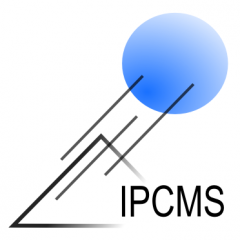
Gracie Chaney (Sorbonne Université, Laboratoire de Chimie Theorique PARIS)
résumé : Although ab initio molecular dynamics (AIMD) can predict the chemical reactions in materials with quantum accuracy, it suffers from computational inefficiency that constrains simulations in size (<1000 atoms) and time (<100 ps). Machine learned interatomic potentials (MLIPs) bridge the gap between quantum accuracy and classical efficiency by learning the potential energy surface of the system from the AIMD data and using it as the force field in classical molecular dynamics (CMD) simulations. In this presentation, I will feature two very different systems for which I have used MLIPS. The first is the interface of a solid-state battery consisting of a Li-metal anode and an argyrodyte Li6PS5Cl solid-state electrolyte. By using a moment-tensor potential scheme we were able to generate an MLIP that accurately predicted the short- and long-term growth of the solid-electrolyte interphase region initiated by reduction of the electrolyte by the anodic Li [2]. The second system consists of a dense liquid of NH3/H2O/CH4 subjected to extreme temperatures (3000 K) and pressures (22-69GPa). In this case, we used an equivariant neural network potential [3] trained on an even distribution of NH3/H2O/CH4 structures of various NH3 amounts (4, 8, and 12). Both the AIMD and MLIP+MD simulations showed that increasing pressure at high temperature induces water ionization and begins a process involving the formation of transient CH5+ molecules and highly reactive carbocations that drive hydrocarbon chain growth toward nanodiamonds. Such results could be useful for understanding the dynamics within icy giant planets, such as Uranus and Neptune.
[1] Ivan S Novikov et al. 2021 Mach. Learn.: Sci. Technol. 2, 025002
[2] Gracie Chaney et al. 2024 ACS Appl. Mater. Interfaces 16, 19, 24624–24630
[3] Musaelian, A., Batzner, S., Johansson, A. et al. (2023) Nat Commun 14, 579
Pour tout contact : Hervé Bulou (0388107095 – herve.bulou@ipcms.unistra.fr) et Christine Goyhenex (0388107097 – christine.goyhenex@ipcms.unistra.fr)

Aliou Sadia TRAORÉ (IPCMS – DSI)
Ce travail de recherche a été réalisé sous la direction du Pr. Ovidiu ERSEN (DSI) et de Dr. Valérie BRIOIS (Synchrotron SOLEIL).

Aram Yoon (Shell Energy Transition Center, Amsterdam)
Résumé : Electrocatalysis plays a pivotal role in various energy conversion and storage applications, including fuel cells, electrolyzers, and batteries. It facilitates the conversion of chemicals from one form to another, making it essential for clean and sustainable energy technologies. Transition metal oxides show great promise in this regard, as they are abundant on Earth and can modify their electrical and chemical properties by adjusting their oxidation state through surface and interface engineering. To effectively harness these materials in energy conversion devices, it is imperative to gain insights into how catalysts’ structures behave in working environments, as this significantly influences chemical conversions and the catalysts’ own chemical status. However, investigating the structure and chemistry of electrocatalysts under electrochemical reaction conditions is a challenging endeavor. Electrochemical systems involve reactions and transformations occurring at multiphase boundaries, including solid-solid and solid-liquid interfaces. This complexity necessitates the use of diverse techniques to probe these interfaces, further complicated by the need to maintain the electrolyte and applied potential.
In my presentation, I will delve into the behavior of Cu2O catalysts under dynamic reaction conditions, employing a multimodal approach centered on in situ Electrochemical Cell Transmission Electron Microscopy (EC-TEM). This approach will focus on two conversion reactions involving Cu2O catalysts: electrochemical CO2 reduction and nitrate reduction. Through this investigation, I will demonstrate structural changes of Cu2O catalysts during redox reactions. The primary emphasis will be on correlating various operando techniques, such as X-ray absorption microscopy and spectroscopy, with electrochemical characterization to gain a comprehensive understanding of how structural heterogeneity impacts catalysis.
Pour tout contact : Maria Letizia De Marco (0388107028 – maria-letizia.demarco@ipcms.unistra.fr)

Alex FETIDA (IPCMS / DSI)
Ce travail a été réalisé sous la direction du Dr. Laurent Limot (DSI).

Orateur: Prof. Kenneth Beyerlein (Institut national de la recherche scientifique, Varennes, Québec, Canada)
Résumé ici

Ce travail de recherche a été réalisé sous la direction du Dr. Christine Boeglin (DSI, IPCMS).
La soutenance est prévue le vendredi 5 avril 2024, à 10h30 dans l’auditorium de l’IPCMS.

Maria Chatzieleftheriou (CPHT, Ecole Polytechnique, Palaiseau)
Résumé : voir affiche jointe

Sophie WEBER (ETH-Zurich, Department of Materials, Zurich, Switzerland)
Theoretical arguments [1,2] and experimental measurements [3-6] have definitively shown that antiferromagnets (AFMs) with particular bulk symmetries can possess a nonzero magnetic dipole moment per unit area or “surface magnetization” on certain surface facets. Such surface magnetization underlies intriguing physical phenomena like interfacial magnetic coupling, and can be used as a readout method of antiferromagnetic domains. However, a universal description and understanding of antiferromagnetic surface magnetization is lacking. I first introduce a classification system based on whether the surface magnetization is sensitive or robust to roughness, and on whether the magnetic dipoles at the surface of interest are compensated or uncompensated. I then show that every type of surface magnetization can be identified and understood in terms of bulk magnetic multipoles, which are already established as symmetry indicators for bulk magnetoelectric responses [7]. This intimate correspondence between antiferromagnetic surface magnetization and magnetoelectric responses at both linear and higher orders reveals that selection and control of the antiferromagnetic order parameter via magnetoelectric annealing may be possible in many more materials and surfaces than previously believed. I use density functional calculations to illustrate that nominally compensated (10-10) and (-12-10) surfaces in magnetoelectric Cr2O3 develop a finite magnetization density at the surface, in agreement with our predictions based on both group theory and the ordering of the bulk multipoles. Finally, I present magnetotransport results by collaborators confirming our ab-initio and theoretical predictions of finite magnetization on these surfaces. Our analysis [8,9] provides a comprehensive basis for understanding the surface magnetic properties and their intimate correspondence to bulk magnetoelectric effects in antiferromagnets, and may have important implications for technologically relevant phenomena such as exchange bias coupling.
[1] A. F. Andreev, JETP Lett. 63, 756 (1996)
[2] K. D. Belashchenko, Phys. Rev. Lett. 105, 147204 (2010)
[3] X. H et al, Nature Mat. 9, 579 (2010)
[4] N. Wu et al., Phys. Rev. Lett. 106, 087202 (2011)
[5] P. Appel et al., Nano Lett. 19, 1682 (2019)
[6] M. S. Wörnle et al., Phys. Rev. B 103, 094426 (2021)
[7] N. A. Spaldin et al., Phys. Rev. B 88, 094429 (2013)
[8] S. F. Weber et al., arXiv:2306.06631 (2023)
[9] O. V. Pylypovskyi, S. F. Weber et al., arXiv 2310.13438 (2023)
Contact : Mébarek ALOUANI : mebarek.alouani@ipcms.unistra.fr

Dr. Svetlana Korneychuk (Karlsruhe Institute of Technology, Institute of Nanotechnology, Germany)
Résumé :
Hydrogen is one of the new energy sources which can take up a leading role in the transfer to the green economy. In this seminar I will demonstrate the application of in-situ TEM to the two major topics in the field of hydrogen technology.
In the first part, I will speak about solid oxide cells which play a key role in the energy transition. They use the chemical energy of the fuel, for instance, hydrogen to produce electricity in a clean way generating only heat and water in the process. Increasing the durability of solid oxide fuel cells is one of the main goals for achieving wider industrial application. The quality of the electrode plays a major role in the performance and durability of a fuel cell. Upon exposure to hydrogen and heat inside in-situ TEM, the reduction mechanism of NiO, a part of NiO/YSZ template for a fuel electrode, can be studied. Using in situ TEM atmosphere system from Protochips the electrode reduction at the H2 pressures up to 1 atmosphere and temperatures up to 850 °C are analyzed. In-situ results go in a good agreement with ex situ results obtained from a bulk cell reduced in a test bench.
Secondly, I am going to address the mechanism of the hydrogen absorption in the nanoscale systems on the example of Pd nanoparticles. Compared to bulk, nanoscale systems interact with hydrogen faster making them more attractive for hydrogen storage, hydrogen detection and catalysis. However, they reveal significant thermodynamic deviations from the bulk due to higher surface to volume ratio, absence of grain boundaries and mechanical stress. Pd is ideal model system to study hydrogen delivery in metals due to its high affinity to hydrogen. In this part I will show the behavior of Pd nanoparticles, in real time with in-situ H2-gas loading in TEM. Initial stages of hydrogen absorption in Pd nanoparticles, local formation of PdHx at different temperatures and pressures can be analyzed by measuring the shift of Pd bulk plasmon with STEM-EELS during in-situ hydrogen loading and unloading in TEM.
Contact : Florian Banhart (florian.banhart@ipcms.unistra.fr)

Anna GALLER / Institute of Theoretical and Computational Physics, Graz University of Technology, Austria
Résumé : Optical phenomena in solids are fascinating and of great importance for technological applications. In this talk, I will first present a novel approach to compute the optical response and color of new inorganic pigment materials from first principles. I will show that the brilliant colors of my target materials, certain transition-metal oxides and rare-earth semiconductors, are strongly influenced by the presence of transition-metal and rare-earth electronic states, whose theoretical treatment requires elaborate many-body techniques.
The second part of the seminar will be focused on nonlinear optical phenomena. I will investigate the response of monolayer hexagonal boron nitride, a prototypical 2D semiconductor, to intense ultrafast laser pulses. I will show that the conduction band charge occupation induced by an elliptically polarized laser can be understood in a multi-photon resonant picture, but remarkably, only if using the Floquet light-dressed states instead of the undressed matter states.
[1] Ransmayr, Tomczak and Galler, PRM 6, 105003 (2022)
[2] Galler, Rubio and Neufeld, J. Phys. Chem. Lett. 14, 50, 11298–11304 (2023)
Pour tout contact : Mébarek ALOUANI : mebarek.alouani@ipcms.unistra.fr

